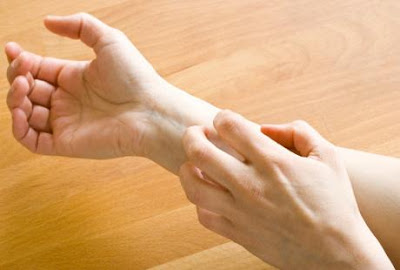What is a latex allergy?
People with a latex allergy are allergic to latex (rubber). Latex is in lots of things: gloves, condoms, diaphragms, rubber bands, balloons, remote controls, waterproofs, shoes, support stockings and so on.
People who often touch latex (for example by their work), are more likely to get this allergy.
There are two types of latex allergies: type 1 and type 4.
People with a latex allergy are often also allergic to tropical fruits, such as banana, kiwi and mango. In this fruit are proteins that resemble those of latex. The same proteins sit in the houseplant ficus benjamin and in the Birch tree. To be sure, so stay away from these plants.
What is a Type 1 latex allergy?
People with type 1 latex allergy may suffer if they get the proteins in latex or breathe on their mucosa. Breathing happens for example when someone is treated by a doctor wearing powdered latex gloves. Contact with the mucous membrane occurs, for example during an operation or a treatment by the dentist.
Type 1 latex allergy symptoms:
People with type 1 latex allergy can then receive the following complaints:
- Sneezing, stuffy and itchy nose.
- Tears and itchy, red eyes.
- Cough, shortness of breath and wheezing.
- Latex gloves give itchy bumps on the hands and the rest of the body.
- Some people get swollen hands, eyelids, lips or tongue.
- Very occasionally someone gets a life-threatening shock.
- You may not touch any latex products.
- Your family doctor and dentist should use latex gloves with you. This also applies to other doctors, surgeons and obstetricians.
- Always wear White Cross Emergency Penning or other medical identification when your allergy state.
- If you are highly allergic, always carry a dose of epinephrine with you. Which you can inject emergency itself.
What is a Type 4 latex allergy?
In people with type-4 latex allergy skin is allergic to latex. This is called contact allergy. The allergic reaction is about 24 to 72 hours after a person has touched latex. Usually get someone like contact dermatitis.
What should you look for in a type-4 latex allergy?
- Does yourself with latex and you get many suffer from eczema, avoid contact with these materials.
- In severe eczema your doctor may prescribe a corticosteroid ointment.
Diagnosis
To establish a type 1 allergy to latex, you get an allergy skin test.
Type-1 allergy is also determined by a blood test. This can be through your family doctor or an allergist. The advantage of blood test is that you can use your normal medication against allergic reactions.
A type-4 latex allergy, the allergist fixed with patch tests. This gives you a bit of latex and some other substances with bandages taped to your skin. Usually on the upper part of your back. After 48 hours and after 72 hours the allergist looks at the reaction of your skin. In a type-4 allergy arise small eczema spots.

